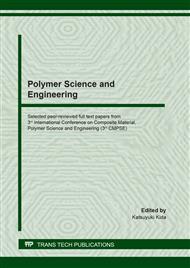p.116
p.122
p.129
p.140
p.146
p.151
p.157
p.165
p.174
Influence of Lithium Oxide on the Characteristics and Mechanical Property in Willemite Crystal Glazes
Abstract:
The effect of lithium Oxide content on the characteristics and mechanical property of willemite (2ZnO.SiO2) under a heating condition in Na2O-K2O-Li2O-CaO-(ZnO)-Al2O3-SiO2 glazing system used in stoneware, sintered at a maximum at temperature 1250 °C by a heating rate of 2.6 °C/min for 8 hours is the firing process of the glazes and clay to melt. After 15 minutes, the temperature dropped to 1100 °C for 40 minutes was stimulated crystallization and soaked in kiln at 1100 °C for 4 hours. This result was consistent with the chemical compositions from the XRF technique indicated that the glaze comprised ZnO and SiO2 were the main compositions and compared to the mineral composition after sintering of the glazed crystal which revealed 2ZnO.SiO2 as the main component and the result from the XRD technique. The microstructure of the glazed crystals after sintering was needle shaped and had spherical growth. The analytical results from Vickers hardness technique showed that microhardness by adding 3-5 % of Li2O of the glazes S1, S2, S3, S4 and S5 as 105.96 ± 4.58, 112.30 ± 9.95, 153.90 ± 7.29, 244.80 ± 5.42 and 382.62 ± 9.20, respectively. More willemite crystals in the glaze results in more strength of the glaze as well.
Info:
Periodical:
Pages:
146-150
Citation:
Online since:
August 2020
Authors:
Keywords:
Price:
Сopyright:
© 2020 Trans Tech Publications Ltd. All Rights Reserved
Share:
Citation:


